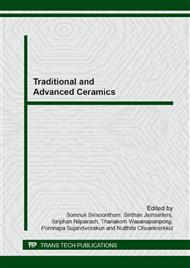p.47
p.62
p.68
p.73
p.79
p.85
p.91
p.97
p.103
Preparation of Xylem-Imitating Porous Ceramic by Coconut Coir and Pottery Clay
Abstract:
The transport of water through xylems in tree is one of the most efficient transport mechanisms. Porous conventional ceramic is one way to mimic capillary force in xylem, which was operated by mixing pottery clay with volatile natural fiber (coconut coir) and extruded into 30 millimeter in diameter rod. The coconut coir content in the mixtures was varied from 0 to 8 wt% of dried clay. Dried samples were fired at 800 °C and 900 °C for 2 h to burn out the coconut coir. The water transport performance test of samples is performed by immersing 3 cm of the initial parts of samples in water and observe watermark at 1, 2, 4, 8 and 16 h under the humidity and temperature controls at 60% and 30 °C, respectively. The sample with the 8 wt% coconut coir after firing at 900 °C showed the highest watermark level at 45 cm from the initial point and the highest water transpiration rate of 2.275 g/h.
Info:
Periodical:
Pages:
79-84
Citation:
Online since:
April 2014
Keywords:
Price:
Сopyright:
© 2014 Trans Tech Publications Ltd. All Rights Reserved
Share:
Citation:


